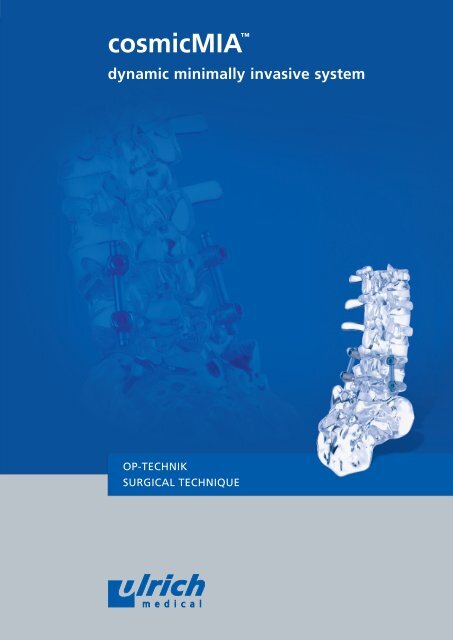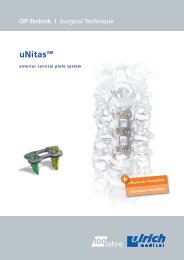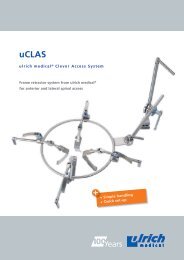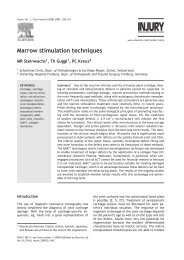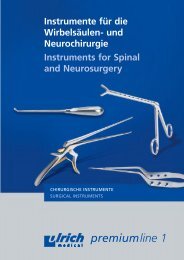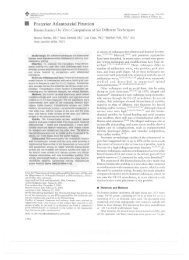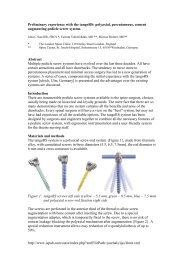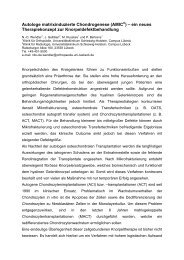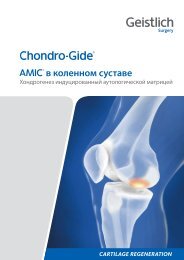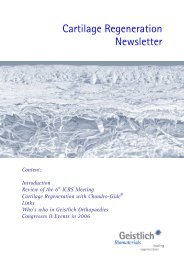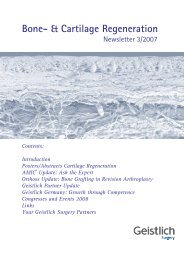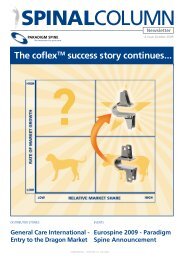cosmicMIA™ Instrumente
cosmicMIA™ Instrumente
cosmicMIA™ Instrumente
- TAGS
- instrumente
- www.mst.ru
Erfolgreiche ePaper selbst erstellen
Machen Sie aus Ihren PDF Publikationen ein blätterbares Flipbook mit unserer einzigartigen Google optimierten e-Paper Software.
cosmicMIA <br />
dynamic minimally invasive system<br />
OP-TECHNIK<br />
SURGICAL TECHNIQUE
1.<br />
2.<br />
3.<br />
4.<br />
5.<br />
6.<br />
7.<br />
OP-Technik<br />
Surgical technique<br />
cosmicMIA<br />
2 cosmicMIA OP-Technik l Surgical technique
Inhalt<br />
Content<br />
i<br />
Einleitung Seite 4<br />
Introduction Page 5<br />
Indikationen und Kontraindikationen Seite 6<br />
Indications and contraindications Page 6<br />
cosmicMIA Implantate Seite 7<br />
cosmicMIA implants Page 7<br />
cosmicMIA <strong>Instrumente</strong> Seite 8<br />
cosmicMIA instruments Page 8<br />
Operationstechnik<br />
Minimalinvasiver Zugang Seite 12<br />
Offener Zugang Seite 26<br />
Surgical technique<br />
Minimally invasive approach Page 12<br />
Open approach Page 26<br />
Siebe Seite 31<br />
Trays Page 31<br />
Komponenten Seite 32<br />
Components Page 33<br />
cosmicMIA OP-Technik l Surgical technique<br />
1.<br />
2.<br />
3.<br />
4.<br />
5.<br />
6.<br />
7.<br />
3
1.<br />
4<br />
Einleitung<br />
cosmicMIA ist ein dynamisches, minimalinvasives<br />
Stab-Schraubensystem zur dorsalen<br />
Stabilisierung der Lendenwirbelsäule<br />
bei degenerativen Erkrankungen. Es kann<br />
die Non-Fusion Technik angewendet werden,<br />
da das Implantat aufgrund seiner<br />
Eigenschaften eine lange Beständigkeit<br />
ohne Fusionierung des instrumentierten<br />
Wirbelsäulenabschnittes gewährleistet.<br />
Durch die Non-fusion Technik wird eine<br />
Beweglichkeit im Segment erhalten und<br />
die Überlastung der Anschlusssegmente<br />
kann vermieden werden. Mit einem<br />
dynamischen Stab-Schraubensystem<br />
kann außerdem die Dämpfungsfunktion<br />
der Bandscheibe aufrecht erhalten werden.<br />
Art. Nr./Art. No. Art. Nr./Art. No.<br />
cosmicMIA OP-Technik l Surgical technique<br />
Die Dynamik des Systems wird durch das<br />
Gelenkkonzept ermöglicht. Das Scharnier<br />
gelenk zwischen Schraubenkopf und<br />
Schraubenunterteil erzeugt eine dauerhaft<br />
be wegliche Verbindung zwischen<br />
Schraube und Stab. Der Stab ist rigide.<br />
Die entstehende Dynamik bewirkt eine<br />
Lastteilung von axialen Kräften zwischen<br />
dem Implantat und der Wirbelsäule. Das<br />
bedeutet, dass ein Teil der Beweglichkeit<br />
in Flexion und Extension erhalten bleibt.<br />
Dadurch werden auch Überlastungen<br />
des Implantates vermieden (Scifert JL et<br />
al., 1999). Gleichzeitig werden jedoch,<br />
häufig schmerzhafte, Rotations- und<br />
Translationsbewegungen zwischen den<br />
zu stabilisierenden Wirbeln sicher eliminiert.<br />
Die cosmicMIA Schrauben werden durch<br />
die Bonit ® -Beschichtung und das konische<br />
Schraubengewinde sicher und dauerhaft<br />
im Wirbelkörper verankert. Die mikroporöse<br />
Oberfläche und die dem Knochen<br />
ähnliche Struktur von Bonit ® fördern<br />
die körpereigene Knochenneubildung<br />
im Bereich der Schraube und damit ein<br />
schnelles Einwachsen.<br />
Die kleinen Bilder in der Fußzeile zeigen die <strong>Instrumente</strong> in chronologischer Reihen folge,<br />
die für die dargestellten OP-Schritte auf einer Doppelseite verwendet werden. Ist das Bild<br />
blau unterlegt, wurde das Instrument bereits verwendet.<br />
The small pictures at the bottom of the page show the step-by-step application of the<br />
instruments that are used as per the surgical steps on the double page. Pictures with<br />
instruments that had been used before are blue-colored.<br />
cosmicMIA kann minimal-invasiv eingesetzt<br />
werden. Für alle Operationsschritte<br />
stehen kanülierte <strong>Instrumente</strong> für eine<br />
geführte Applikation sowie kanülierte<br />
Schrauben zur Verfügung. Für den<br />
Patienten bedeutet die geringe Invasivität<br />
ein reduziertes Operationstrauma und<br />
reduzierter Blutverlust sowie kürzere OP-<br />
und Hospitalisationszeiten.<br />
Die vorliegende OP-Technik beschreibt<br />
das Implantat und die <strong>Instrumente</strong><br />
sowie die Arbeitsschritte für die<br />
Anwendung des cosmicMIA Systems. Die<br />
OP-Technik ist als alleinige Grundlage<br />
für die erfolgreiche Anwendung des<br />
Wirbelsäulensystems cosmicMIA nicht<br />
ausreichend. Es wird empfohlen, die<br />
Operationstechnik bei einem erfahrenen<br />
Operateur zu erlernen. Bitte beachten<br />
Sie die Wiederaufbereitungsanweisung<br />
für <strong>Instrumente</strong>.<br />
patented<br />
or/and<br />
pat. pend.
Introduction<br />
cosmicMIA is a dynamic, minimally invasive<br />
rod-screw system for the posterior<br />
stabilization of the lumbar spine in the<br />
case of degenerative spine diseases. The<br />
non-fusion technique can be used as the<br />
implant ensures a long term resistance<br />
without any fusion of the instrumented<br />
spine section on account of its properties.<br />
On account of the non-fusion technique<br />
the mobility in the segment is preserved<br />
and overloading of the adjacent<br />
segments can be avoided. The shock<br />
absorbing function of the disk is maintained,<br />
due to the dynamic rod-screw<br />
system.<br />
Literatur l Literature<br />
Scifert JL, Sairyo K, Goel VK, Grobler LJ,<br />
Grosland NM, Spratt KF, Chesmel KD, Spine,<br />
24, No 2 1, 22 06-22 13, 1999, Stability<br />
Analysis of an Enhanced Load Sharing<br />
Posterior Fixation Device and Its Equivalent<br />
Conventional Device in a Calf Spine Model.<br />
Strempel A, Moosmann D, Stoss C,<br />
Martin A, World Spine Journal, 1/1, 40-47,<br />
2 006, Stabilisation of the Degenerated<br />
Lumbar Spine in the Nonfusion Technique<br />
with cosmic Posterior Dynamic System.<br />
Strempel A, Stoss C, Moosmann D, Martin<br />
A, Coluna/Columna, 5 , No 1, 2 7-34, 2006,<br />
Non-fusion stabilization of the lumbar spine<br />
in the case of degenerative diseases with a<br />
dynamic pedicle screw rod system.<br />
The hinge concept enables the dynamization<br />
of the system. The hinged<br />
joint between the screw head and the<br />
threaded portion of the screw produces<br />
a permanently movable connection<br />
between screw and rod. The rod is rigid.<br />
The arising dynamic causes an axial load<br />
sharing between the implant and the<br />
spine. This means that mobility in flexion<br />
and extension is partially preserved.<br />
Overload conditions of the implant are<br />
avoided as well (Scifert JL et al., 1999).<br />
At the same time frequently painful rotation<br />
and translation movements in the<br />
lumbar spine are safely eliminated.<br />
The cosmicMIA screw is coated with<br />
Bonit ® and has a conical screw thread for<br />
a safely and permanent anchoring in the<br />
vertebral body. Bonit ® features a microporous<br />
surface and a structure similar<br />
to bone which supports the body’s own<br />
new formation of bone in the region<br />
of the screw, and consequently a fast<br />
ingrowth.<br />
cosmicMIA can be used minimally invasive.<br />
Cannulated instruments for guided<br />
application as well as cannulated screws<br />
are available in all surgery steps. For<br />
the patient the less invasivity means a<br />
reduced surgery trauma and reduced<br />
blood loss as well as shorter surgery and<br />
hospitalization times.<br />
The present surgical technique describes<br />
the implant and the instruments as well<br />
as the procedure of the application of<br />
cosmicMIA. The surgical technique is<br />
not sufficient as the sole basis for the<br />
successful use of cosmicMIA. It is recommended<br />
to study and learn the operating<br />
technique with and from an experienced<br />
surgeon. Please note the instructions for<br />
reprocessing treatment for instruments.<br />
cosmicMIA OP-Technik l Surgical technique<br />
cosmicMIA<br />
1.<br />
5
2.<br />
6<br />
Indikationen und Kontraindikationen<br />
Indications and contraindications<br />
Indikationen<br />
cosmicMIA ist ein Implantatsystem zur operativen dorsalen<br />
Stabilisierung, Fixierung und Korrektur von Fehlstellungen der<br />
menschlichen Brust- und Lendenwirbelsäule und des Sakrums<br />
bei degenerativen Wirbelsäulenerkrankungen.<br />
Bei degenerativen Wirbelsäulenerkrankungen ohne wesentliche<br />
Substanzdefekte der vorderen Säule und ohne Korrek turnotwendigkeit<br />
ist die Anwendung in der Non-Fusion Technik<br />
möglich.<br />
Bei langen Stabilisierungen erhöht sich die Belastung innerhalb<br />
des instrumentierten Abschnitts. Wir empfehlen deshalb,<br />
bei der Non-Fusion Technik die Instrumentierung auf drei<br />
Segmente zu begrenzen. Sind längere Instrumentierungen<br />
notwendig, muss ein Teil der Segmente fusioniert werden.<br />
Kontraindikationen<br />
Patienten mit akuter sowohl oberflächlicher als auch tiefgehender<br />
Infektion<br />
Patienten mit Fieber oder Leukozytose<br />
Patienten mit Obesität<br />
Patienten mit nachgewiesener Metallallergie oder Neigung<br />
zur Fremdkörperreaktionen<br />
Patienten ohne adäquate Compliance, die aufgrund ihres<br />
geistigen bzw. neurologischen Zustands nicht willens oder<br />
fähig sind, sich an die Nachsorgeanweisungen zu halten<br />
Bei Patienten mit einem ungünstigen medizinischen oder<br />
psychologischen Allgemeinzustand, der durch den Eingriff<br />
weiter verschlechtert werden könnte, ist eine sorgfältige<br />
Abwägung durch den behandelnden Arzt vorzunehmen<br />
Patienten mit unzureichender Knochenqualität oder -quantität,<br />
z.B. schwere Osteoporose, Osteopenie, Osteomyelitis<br />
Schwangerschaft<br />
cosmicMIA OP-Technik l Surgical technique<br />
m, 87 J., Pseudolisthese und<br />
zentrale Stenose<br />
m, 87 yrs, pseudolisthesis and<br />
central stenosis<br />
Indications<br />
cosmicMIA is an implant system for operative posterior stabilization,<br />
fixation and correction of misalignment of the thoracic<br />
and lumbar spine and the sacrum in case of degenerative spine<br />
diseases.<br />
With degenerative spine diseases without significant substance<br />
defects of the anterior column and without the necessity for<br />
correction, it is possible to apply the non-fusion technique.<br />
With long stabilizations, the stress inside the section of the<br />
instrumentation increases. We therefore recommend limiting<br />
the instrumentation to three segments for the non-fusion technique.<br />
If longer instrumentations are necessary, some of the<br />
segments will have to be fused.<br />
Contraindications<br />
Patients with acute superficial and deep infection<br />
Patients with fever or leukocytosis<br />
Patients with obesity<br />
Patients with documented metal allergy or tendency to react<br />
to foreign bodies<br />
Patients without adequate compliance who are not able due<br />
to their mental and/or neurological state or capable of adhering<br />
to the aftercare instructions<br />
In patients with a poor general medical or psychological<br />
condition which could be further exacerbated by the intervention,<br />
the attending physician must carefully weigh the risks<br />
and benefits<br />
Patients with insufficient bone mass or bone quality, e.g.<br />
severe osteoporosis, osteopenia, osteomyelitis<br />
Pregnancy<br />
Stabilisierung L4/L5 mit cosmicMIA<br />
Stabilization L4/L5 with cosmicMIA<br />
Landeskrankenhaus Feldkirch, Österreich<br />
Landeskrankenhaus Feldkirch, Austria
cosmicMIA Implantate<br />
cosmicMIA implants<br />
Die cosmicMIA Implantate sind alle steril<br />
verpackt. Aufkleber für die Patientenakte<br />
sind enthalten.<br />
CS 2600-6-XX, CS 2600-7-XX<br />
cosmicMIA Schraube<br />
Die cosmicMIA Schraube ist kanüliert<br />
und konifiziert. Das Gewinde ist selbstschneidend<br />
und mit Bonit ® beschichtet.<br />
Die dynamische Instrumentierung wird<br />
durch das Scharniergelenk zwischen<br />
Schraubenkopf und Gewindeteil ermöglicht.<br />
Die cosmicMIA Schraube steht in den<br />
Durchmessern 6,5 mm und 7,5 mm zur<br />
Verfügung. Die Schraubenlängen sind<br />
in 5 mm Schritten abgestuft von 30 bis<br />
55 mm.<br />
CS 2605<br />
cosmicMIA Fixierschraube<br />
Zur Fixierung der Stab-Schrauben-<br />
Ver bin dung<br />
CS 2608-XXX<br />
cosmicMIA Stab<br />
Ø 6,0 mm, blau<br />
Längen 40 mm bis 120 mm, 200 mm (10<br />
mm Schritte)<br />
Bohrungen an beiden Enden<br />
Die Lasermarkierung zeigt den Bereich<br />
an, innerhalb dessen die Schraube am<br />
Stab fixiert werden darf<br />
The cosmicMIA implants are all packaged<br />
sterile. Adhesive labels for the patient file<br />
are included.<br />
cosmicMIA screw<br />
The cosmicMIA screw is cannulated and<br />
has a conical core. The thread is selfcutting<br />
and coated with Bonit ® . The<br />
dynamic instrumentation is enabled by<br />
the hinged joint between thread and<br />
screw head.<br />
The cosmicMIA screw is available in two<br />
diameters 6.5 mm and 7.5 mm. The<br />
screw lengths are available in 5 mm<br />
increments from 30 to 55 mm.<br />
cosmicMIA locking screw<br />
For fixing the rod-screw connection<br />
cosmicMIA rod<br />
Ø 6.0 mm, blue<br />
Lengths 40 mm to 120 mm, 200 mm<br />
(10 mm increments)<br />
Boreholes at both ends<br />
The laser marking indicates the area<br />
within which the screw may be fixed to<br />
the rod<br />
cosmicMIA OP-Technik l Surgical technique<br />
3.<br />
7
4.<br />
8<br />
cosmicMIA <strong>Instrumente</strong><br />
cosmicMIA instruments<br />
CS 2620-06, -07<br />
Ahle,<br />
für Schrauben<br />
Ø 6,5 mm, Ø 7,5 mm<br />
CS 2624<br />
Führungsdraht,<br />
Ø 1,5 mm, Länge 500 mm<br />
CS 2626-02<br />
Dilatator,<br />
Ø 19 mm, Länge 120 mm<br />
cosmicMIA OP-Technik l Surgical technique<br />
CS 2622<br />
Trokardraht für Ahle<br />
CS 2626-01<br />
CS 2626-03<br />
CS 2626-04 CS 2628<br />
Bohrdraht,<br />
Ø 1,5 mm, Länge 160 mm<br />
Awl,<br />
for screw Ø 6.5 mm,<br />
Ø 7.5 mm<br />
Guide wire,<br />
Ø 1.5 mm, length 500 mm<br />
Dilator,<br />
Ø 19 mm, length 120 mm<br />
Drill wire,<br />
Ø 1.5 mm, length 160 mm<br />
Dilatator,<br />
Ø 12 mm, Länge 160 mm<br />
Arbeitshülse,<br />
Ø 22 mm, Länge 100 mm<br />
Messinstrument<br />
für Schraubenlänge<br />
Trocar wire for awl<br />
Dilator,<br />
Ø 12 mm, length 160 mm<br />
Working sleeve,<br />
Ø 22 mm, length 100 mm<br />
Gauge for screw length
cosmicMIA <strong>Instrumente</strong><br />
cosmicMIA instruments<br />
CS 2630-06, -07 CS 2632<br />
Gewindeschneider,<br />
für Schrauben Ø 6,5 mm,<br />
Ø 7,5 mm<br />
CS 2633-01<br />
Führungshülse<br />
CS 2633-03<br />
Hülse für CS 2632<br />
CS 2633-05<br />
Aufsatz für CS 2633-01<br />
Tap,<br />
for screw Ø 6.5 mm,<br />
Ø 7.5 mm<br />
Guide sleeve<br />
Sleeve for CS 2632<br />
Attachment for CS 2633-01<br />
Schraubendreher<br />
CS 2633-02<br />
Montageinstrument<br />
für CS 2633-01<br />
CS 2633-04<br />
Fixierdraht für CS 2632<br />
CS 2633-06<br />
Stab-Schrauben-<br />
Verbindungsinstrument<br />
Screwdriver<br />
Assembling instrument<br />
for CS 2633-01<br />
Fixation wire for CS 2632<br />
Rod-screw connecting<br />
instrument<br />
cosmicMIA OP-Technik l Surgical technique<br />
4.<br />
9
4.<br />
cosmicMIA <strong>Instrumente</strong><br />
cosmicMIA instruments<br />
CS 2633-07<br />
Remontageinstrument<br />
für CS 2633-01<br />
CS 2636<br />
Messinstrument<br />
für Stablänge<br />
CS 2640<br />
Nachdreher für Schrauben<br />
CS 2645-01<br />
Drehmomentschraubendreher,<br />
8 Nm,<br />
Länge 310 mm<br />
10 cosmicMIA OP-Technik l Surgical technique<br />
Reattaching instrument<br />
for CS 2633-01<br />
Gauge for rod length<br />
Tightener for screws<br />
Torque wrench,<br />
8 Nm, length 310 mm<br />
CS 2633-08<br />
Hülse für CS 2633-06<br />
CS 2638<br />
Stabfassklemme, fein<br />
CS 2642<br />
Schraubendreher<br />
für Fixierschraube<br />
CS 2645-02<br />
Gegenhalter für<br />
Drehmomentschraubendreher,<br />
Ø 20 mm,<br />
Länge 155 mm<br />
Sleeve for CS 2633-06<br />
Forceps for rod, delicate<br />
Screwdriver<br />
for locking screw<br />
Counterpart for torque<br />
wrench, Ø 20 mm,<br />
length 155 mm
cosmicMIA <strong>Instrumente</strong><br />
cosmicMIA instruments<br />
CS 2645-03<br />
Gegenhalter für<br />
Drehmomentschraubendreher,<br />
Ø 15 mm,<br />
Länge 210 mm<br />
CS 2791<br />
Distraktionszange<br />
CS 5788<br />
Größentaster<br />
UT 1641-29<br />
Stabbiegezange nach<br />
Lepine, Länge 290 mm<br />
Counterpart for torque<br />
wrench, Ø 15 mm,<br />
length 210 mm<br />
Distraction forceps<br />
Measuring caliper<br />
Rod bending forceps acc. to<br />
Lepine, length 290 m<br />
CS 2760-150<br />
Phantomstab,<br />
Länge 150 mm<br />
CS 3024<br />
Stabfasszange,<br />
Länge 190 mm<br />
UL 8522-27<br />
Pedikelsonde,<br />
Länge 270 mm<br />
Phantom rod,<br />
length 150 mm<br />
Rod holder,<br />
length 190 mm<br />
Ball tip probe,<br />
length 270 mm<br />
cosmicMIA OP-Technik l Surgical technique<br />
4.<br />
11
5.<br />
12<br />
Operationstechnik<br />
Surgical technique<br />
Minimal-invasiver Zugang<br />
Minimally invasive approach<br />
CS 2622<br />
CS 2620-06, -07<br />
cosmicMIA OP-Technik l Surgical technique<br />
CS 2624<br />
Exposition der<br />
Wirbelsäule<br />
Der geeignete Zugang wird<br />
ge wählt.<br />
Montage der Ahle<br />
Der Trokardraht (CS 2622)<br />
wird in die Ahle (CS 2620-<br />
06, -07) eingeschraubt. Für<br />
die verschiedenen Schrauben<br />
durchmesser 6,5 mm und<br />
7,5 mm stehen die passenden<br />
kanülierten Ahlen zur<br />
Verfügung.<br />
Exposure of the<br />
posterior spine<br />
The optimal approach point is<br />
selected.<br />
Assembly of the<br />
cannulated awl<br />
The trocar wire (CS 2622) is<br />
screwed in the awl (CS 2620-<br />
06, -07). For the various screw<br />
diameters 6.5 mm and 7.5<br />
mm, suitable cannulated awls<br />
are available.
Operationstechnik<br />
Surgical technique<br />
Vorbereitung des Pedikels<br />
Die Kortikalis des Pedikels wird<br />
am Eintrittspunkt mit der<br />
kanülierten Ahle (CS 2620-06,<br />
-07) inklusive Trokardraht (CS<br />
2622) eröffnet. Das Schraubenloch<br />
wird weiter präpariert, bis<br />
die Spitze der Ahle dort liegt,<br />
wo die Schraubenspitze zu liegen<br />
kommen soll. Im Anschluss<br />
wird der Trokardraht entfernt,<br />
die Ahle verbleibt im Pedikel.<br />
Soll S1 implantiert werden,<br />
wird eine bikortikale Schrauben<br />
lage empfohlen.<br />
Wichtig: Laterale und ap<br />
Bildwandlerkontrolle.<br />
Einsetzen des<br />
Führungsdrahtes<br />
Der Führungsdraht (CS 2624)<br />
wird durch die kanülierte<br />
Ahle eingesetzt. Anschließend<br />
wird die Ahle entfernt, während<br />
der Führungsdraht im<br />
Wirbelkörper verbleibt.<br />
Preparing the pedicle<br />
Using the cannulated awl (CS<br />
2620-06, -07) with the included<br />
trocar wire (CS 2622), the<br />
cortical bone of the pedicle is<br />
opened. The screw hole is<br />
prepared. The tip of the awl<br />
has to be placed where the<br />
screw tip will be located.<br />
Afterwards the trocar wire is<br />
removed while the awl remains<br />
in the pedicle. For the application<br />
in S1 a bicortical screw<br />
placement is recommended.<br />
Important: Use of a C-arm<br />
control is recommended (ap<br />
and lateral view).<br />
Inserting the guide wire<br />
The guide wire (CS 2624) is<br />
inserted via the cannulated<br />
awl. Afterwards the awl is<br />
removed while the guide wire<br />
remains in the vertebral body.<br />
cosmicMIA OP-Technik l Surgical technique<br />
5.<br />
13
5.<br />
14<br />
Operationstechnik<br />
Surgical technique<br />
CS 2626-01 CS 2626-02<br />
cosmicMIA OP-Technik l Surgical technique<br />
CS 2626-03<br />
Dilatation<br />
Über den Führungsdraht werden<br />
nun die Dilatatoren eingebracht,<br />
um einen Arbeitskanal<br />
für das Einbringen der Schrauben<br />
zu schaffen. Der Dilatator,<br />
Ø 12 mm (CS 2626-01) wird<br />
über den Füh rungs draht<br />
ge schoben. Dann werden<br />
nach einander der Dilatator,<br />
Ø 19 mm (CS 2626-02) und<br />
die Arbeitshülse (CS 2626-03)<br />
aufgesetzt.<br />
Schaffung des<br />
Arbeitskanals<br />
Bei Bedarf kann die Arbeitshülse<br />
mit Hilfe eines Bohrdrahtes<br />
(CS 2626-04) über das<br />
seitlich angebrachte Röhrchen<br />
am Knochen fixiert werden.<br />
Die Dilatatoren (CS 2626-01,<br />
CS 2626-02) werden jetzt<br />
wieder entfernt. Die Arbeitshülse<br />
(CS 2626-03) verbleibt<br />
in situ.<br />
Dilatation<br />
The dilators are introduced<br />
over the guide wire, in order<br />
to create a working channel<br />
for the insertion of the screws.<br />
The dilator, Ø 12 mm (CS<br />
2626-01), is pushed over the<br />
guide wire. The dilator, Ø 19<br />
mm (CS 2626-02), is then fitted,<br />
followed by the working<br />
sleeve (CS 2626-03).<br />
Creating the<br />
working channel<br />
If required, a drill wire (CS<br />
2626-04) can be inserted in<br />
the laterally attached tube in<br />
order to affix the working<br />
sleeve to the bone. The dilators<br />
(CS 2626-01, CS 2626-<br />
02) are then removed. The<br />
working sleeve (CS 2626-03)<br />
remains in situ.<br />
CS 2624-04 CS 2628 CS 2630-06, -07
Operationstechnik<br />
Surgical technique<br />
Bestimmung der<br />
Schraubenlänge<br />
Das Messinstrument für die<br />
Schraubenlänge (CS 2628)<br />
wird über den Führungsdraht<br />
ge schoben und auf den<br />
Knochen aufgesetzt. Mit Hilfe<br />
der Lasermarkierung, die auf<br />
dem Führungsdraht angebracht<br />
ist, wird die Länge der<br />
Schraube am Messinstrument<br />
abgelesen. Die Spitze des Führungs<br />
drahtes muss dort liegen,<br />
wo die Schraubenspitze<br />
zu liegen kommen soll. Bei S1<br />
liegt bei bikortikaler Verschrau<br />
bung die Spitze des<br />
Füh rungs drahtes der Gegenkortikalis<br />
an. Die abgelesene<br />
Länge wird auf die nächst<br />
kleinere abgerundet.<br />
Wichtig: Laterale Bild wandler<br />
kontrolle.<br />
Gewindeschneiden für<br />
cosmicMIA Schraube<br />
Zur Unterstützung der Pedikelpräparation<br />
bei sklerotischer<br />
Wirbelspongiosa kann der<br />
Gewindeschneider (CS 2630-<br />
06, -07) optional verwendet<br />
werden. Um im Os sacrum<br />
eine bikortikale Verschraubung<br />
vorzubereiten, sollte mit dem<br />
Ge winde schneider die Gegenkortikalis<br />
perforiert werden.<br />
Wichtig: Der Führungsdraht<br />
muss in Position gehalten werden,<br />
damit dieser nicht nach<br />
vorne geschoben wird.<br />
Late rale Bildwandlerkontrolle.<br />
Determining the<br />
screw length<br />
The gauge for the screw<br />
length (CS 2628) is applied via<br />
the guide wire and positioned<br />
on the bone. Use the laser<br />
marking on the guide wire to<br />
read the length of the screw<br />
on the gauge. The tip of the<br />
guide wire has to be placed<br />
where the screw tip is to be<br />
located. Given bicortical screw<br />
placement in S1, the tip of the<br />
guide wire is located at the<br />
counter-corticalis. The length<br />
read is rounded down to the<br />
next lower.<br />
Important: Use of a C-arm<br />
control is recommended (lateral<br />
view).<br />
Tapping for<br />
cosmicMIA screw<br />
In order to support the pedicle<br />
preparation in cases of sclerotic<br />
bone the tap (CS 2630-<br />
06, -07) may be used. In order<br />
to prepare a bicortical screw<br />
placement in the os sacrum,<br />
the counter-corticalis should<br />
be perforated with the tap.<br />
Important: Hold the guide<br />
wire in position that it is not<br />
pushed forward.<br />
Use of a C-arm is recommended<br />
(lateral view).<br />
cosmicMIA OP-Technik l Surgical technique<br />
5.<br />
15
5.<br />
16<br />
Operationstechnik<br />
Surgical technique<br />
CS 2633-05 CS 2633-02 CS 2633-01 CS 2632<br />
cosmicMIA OP-Technik l Surgical technique<br />
Montage von Schraube<br />
und Führungshülse<br />
Der Aufsatz (CS 2633-05) wird<br />
auf das Montageinstrument<br />
(CS 2633-02) aufgesetzt. An -<br />
schließend wird das Mon tagein<br />
stru ment bis zum An schlag<br />
in die Füh rungs hülse (CS<br />
2633-01) ge schoben und<br />
dadurch die Führungshülse<br />
aufgespreizt (Drehen des<br />
Instruments).<br />
Montage von Schraube<br />
und Führungshülse<br />
Die cosmicMIA Schraube wird<br />
in die Führungshülse (CS<br />
2633-01) gelegt. Dabei ist<br />
darauf zu achten, dass die Pins<br />
der Führungshülse in die<br />
Nuten der Schraube fassen.<br />
Durch Drücken gegen den<br />
Aufsatz (CS 2633-05) wird die<br />
Führungshülse nach vorne<br />
geschoben und so das Montage<br />
instrument entnommen.<br />
Die Schraube rastet mit einem<br />
Klick geräusch in der Führungshülse<br />
ein. Die Schraube muss<br />
dabei in Position gehalten<br />
werden.<br />
Assembly of screw<br />
and guide sleeve<br />
The attachment (CS 2633-05)<br />
is placed on the assembling<br />
instrument (CS 2633-02).<br />
The assembling instrument is<br />
inserted into the guide sleeve<br />
(CS 2633-01) until it reaches<br />
the limit stop (turning of<br />
instrument). The guide sleeve<br />
is spread by the assembling<br />
instrument.<br />
Assembly of screw<br />
and guide sleeve<br />
The cosmicMIA screw is<br />
placed in the guide sleeve (CS<br />
2633-01). Please make sure in<br />
the assembly that the pins of<br />
the guide sleeve have to be<br />
inserted into the grooves of<br />
the screw. The guide sleeve<br />
is pushed forward by bearing<br />
against the attachment (CS<br />
2633-05) and the assembling<br />
instrument is removed. The<br />
screw engages in the guide<br />
sleeve with a clicking sound.<br />
Hold the screw in position<br />
while attaching the guide<br />
sleeve.
Operationstechnik<br />
Surgical technique<br />
Montage von Schraube<br />
und Schraubendreher<br />
Der Schraubendreher (CS<br />
2632) wird durch die Führungshülse<br />
in den Schrau ben kopf<br />
eingesetzt. Durch Festdrehen<br />
der Rändel schraube des<br />
Schrau ben drehers wird die<br />
Schraube fixiert.<br />
Implantieren der<br />
cosmicMIA Schraube<br />
Die cosmicMIA Schraube<br />
wird über den liegenden<br />
Füh rungs draht mit dem<br />
Schraubendreher (CS 2632)<br />
inklusive Führungshülse (CS<br />
2633-01) implantiert. Das<br />
Schraubengelenk wird über<br />
den Führungsdraht blockiert.<br />
Die Schraube soll so weit<br />
eingedreht werden, dass<br />
der Schraubenkopf Kontakt<br />
zum Knochen hat und die<br />
Schraubenspitze dort platziert<br />
ist, wo sich die Spitze<br />
des Führungsdrahtes befunden<br />
hat. Es ist darauf zu<br />
achten, dass die Schrauben<br />
zueinander ausgerichtet werden<br />
(Markierung auf dem<br />
Schraubendreher entsprechend<br />
der Stabposition).<br />
Wichtig: Der Führungsdraht<br />
muss in Position gehalten<br />
werden, damit dieser nicht<br />
beim Eindrehen der Schraube<br />
nach vorne geschoben wird!<br />
Laterale Bildwandlerkontrolle<br />
Assembly of screw<br />
and screwdriver<br />
The screwdriver (CS 2632) is<br />
inserted in the screw head<br />
through the guide sleeve.<br />
Turning the locking nut of<br />
the screwdriver secures the<br />
screw.<br />
Implanting the<br />
cosmicMIA screw<br />
The cosmicMIA screw is<br />
implanted with the screwdriver<br />
(CS 2632) and guide<br />
sleeve (CS 2633-01) via the<br />
guide wire. The screw joint is<br />
blocked over the guide wire.<br />
The screw should be screwed<br />
in so far that the screw head<br />
makes contact with the bone<br />
and the screw tip is placed<br />
where the tip of the guide wire<br />
had been. Please make sure<br />
that the screws are aligned to<br />
each other (Marking on the<br />
screwdriver according to the<br />
rod position).<br />
Important: Hold the guide<br />
wire in position, that it is not<br />
pushed forward while placing<br />
the screw! Use of a C-arm is<br />
recommended (lateral view).<br />
cosmicMIA OP-Technik l Surgical technique<br />
5.<br />
17
5.<br />
18<br />
Operationstechnik<br />
Surgical technique<br />
CS 2632 CS 2640 CS 2636 UT 1641-29 CS 2633-01 CS 2633-07<br />
cosmicMIA OP-Technik l Surgical technique<br />
Implantieren der<br />
cosmicMIA Schraube<br />
Der Schraubendreher, der<br />
Führungsdraht und die<br />
Arbeitshülse werden entnommen,<br />
die Führungs hülse<br />
verbleibt in situ. Die zweite<br />
Schraube wird mit der gleichen<br />
Technik wie die erste<br />
implantiert. Es ist darauf zu<br />
achten, dass die Hülsen parallel<br />
stehen.<br />
Wichtig: Die Schrauben nicht<br />
mit Hilfe der Führungshülsen<br />
drehen. Immer den Schrauben<br />
dreher (CS 2632) oder<br />
Nach dreher (CS 2640) verwenden!<br />
Bestimmung der Stablänge<br />
Mit Hilfe des Messinstruments<br />
(CS 2636) kann die Stablänge<br />
festgelegt werden. Das Messinstrument<br />
wird bis zum<br />
Anschlag in die Bohrungen<br />
der parallel nebeneinander<br />
stehenden Führungshülsen<br />
geschoben. Bei Bedarf kann<br />
der cosmicMIA Stab mit Hilfe<br />
der Stabbiegezange nach<br />
Lepine (UT 1641-29) in die<br />
passende Form gebracht werden.<br />
Wichtig: Die Länge des<br />
Stabes an der Außenseite der<br />
Führungshülse ablesen. Die<br />
Führungshülsen nicht mit Hilfe<br />
des Messinstruments drehen.<br />
Implanting the<br />
cosmicMIA screw<br />
The screwdriver, the guide<br />
wire, and the working sleeve<br />
are removed, while the guide<br />
sleeve remains in situ. The<br />
second screw is implanted<br />
with the same technique as<br />
the first, making sure that the<br />
guide sleeves are aligned in a<br />
parallel position.<br />
Important: Do not use the<br />
guide sleeves to move the<br />
screws. Always use the screwdriver<br />
(CS 2632) or tightener<br />
(CS 2640)!<br />
Determining the rod length<br />
With the gauge (CS 2636),<br />
the rod length is determined.<br />
The gauge is inserted into<br />
the boreholes of the parallel<br />
guide sleeves until it reaches<br />
the limit stop. Using the rod<br />
bending forceps (UT 1641-<br />
29), the cosmicMIA rod can be<br />
contoured to its optimal form,<br />
if necessary.<br />
Important: Note the length<br />
of the rod, which is marked<br />
on the outer edge of the guide<br />
sleeve. Do not use the gauge<br />
to move the guide sleeves.
Operationstechnik<br />
Surgical technique<br />
CS 2633-05<br />
Aufsetzen der<br />
Führungshülse in situ<br />
Falls die Führungshülse<br />
noch einmal in situ aufgesetzt<br />
werden muss, kann das<br />
Remontageinstrument hierfür<br />
verwendet werden.<br />
Das Montageinstrument (CS<br />
2633-02) wird auf die Führungs<br />
hülse (CS 2633-01) aufgesetzt.<br />
Das Re mon tage instrument<br />
(CS 2633-07) wird in die<br />
Schraube eingeschraubt, die<br />
Führungshülse mit Montageinstrument<br />
darüber geschoben.<br />
Mit Hilfe dieser Führung<br />
kann die Schraube wieder mit<br />
der Führungshülse verbunden<br />
werden.<br />
Bei Bedarf kann der Aufsatz<br />
(CS 2633-05) zur Montage<br />
verwendet werden.<br />
Inserting the<br />
guide sleeve in situ<br />
In case of assembling the<br />
guide sleeve in situ again the<br />
re attaching instrument can be<br />
used.<br />
The assembling instrument<br />
(CS 2633-02) is placed on<br />
the guide sleeve (CS 2633-<br />
01). The reattaching instrument<br />
(CS 2633-07) is screwed<br />
into the screw and the guide<br />
sleeve is placed over it with<br />
the assembling instrument.<br />
Using the guide, the screw<br />
can be reconnected to the<br />
guide sleeve.<br />
If necessary, the attachment<br />
(CS 2633-05) can be used for<br />
the assembly.<br />
cosmicMIA OP-Technik l Surgical technique<br />
5.<br />
19
5.<br />
20<br />
Operationstechnik<br />
Surgical technique<br />
CS 2638 CS 3024 CS 2640<br />
cosmicMIA OP-Technik l Surgical technique<br />
Einsetzen des Stabes<br />
Der cosmicMIA Stab wird mit<br />
Hilfe der Stabfassklemme (CS<br />
2638) oder der Stabfasszange<br />
(CS 3024) in die Öffnungen<br />
der Führungshülsen geführt.<br />
Zur Unterstützung der Stabführung<br />
können an den Enden<br />
des Stabes Fäden befestigt<br />
werden.<br />
Einsetzen des Stabes<br />
Mit Hilfe des Nachdrehers (CS<br />
2640), der durch die Führungs<br />
hülse aufgesetzt wird,<br />
kann der cosmicMIA Stab<br />
nach unten in die Schrau benköpfe<br />
gedrückt werden. Die<br />
Führungshülsen sollten dabei<br />
senkrecht zum Stab stehen.<br />
Die beiden Fäden werden<br />
dabei unter Spannung gehalten,<br />
um ein Verrutschen des<br />
Stabes aus den Schrau benköpfen<br />
zu vermeiden.<br />
Inserting the rod<br />
The cosmicMIA rod is inserted<br />
in the openings of the guide<br />
sleeves using the forceps for<br />
the rod (CS 2638) or the rod<br />
holder (CS 3024).<br />
Threads can be fixed at the<br />
ends of the rod to support the<br />
rod guidance.<br />
Inserting the rod<br />
Using the tightener (CS 2640),<br />
which is positioned through<br />
the guide sleeve, the cosmicMIA<br />
rod can be pressed<br />
down into the screw heads.<br />
The guide sleeves should be<br />
positioned perpendicular to<br />
the rod. The two threads are<br />
tensioned in order to prevent<br />
the rod from slipping out of<br />
the screw heads.
Operationstechnik<br />
Surgical technique<br />
CS 2642<br />
Befestigen der<br />
Fixierschraube<br />
Die cosmicMIA Fixierschraube<br />
wird auf den Schraubendreher<br />
(CS 2642) aufgesetzt und<br />
durch Überschieben der Hülse<br />
fixiert.<br />
Fixieren von Schraube<br />
und Stab<br />
Die cosmicMIA Fixierschraube<br />
wird mit dem Schraubendreher<br />
(CS 2642) durch die Füh rungshülse<br />
in die cosmicMIA Schraube<br />
eingedreht und an gezogen.<br />
Die abschließende Fixierung<br />
erfolgt mit dem Dreh mo mentschraubendreher<br />
(CS 2645-01)<br />
mit 8 Nm. (Siehe S. 23)<br />
Fixing the<br />
locking screw<br />
The cosmicMIA locking screw<br />
is attached to the screwdriver<br />
(CS 2642) and fixed in position<br />
by pushing on the sleeve.<br />
Fixing of screw<br />
and rod<br />
The cosmicMIA locking screw<br />
is applied through the guide<br />
sleeve and gentle tightened<br />
using the screwdriver (CS<br />
2642). The final tightening is<br />
completed with the torque<br />
wrench (CS 2645-01) to 8<br />
Nm (see page 23).<br />
cosmicMIA OP-Technik l Surgical technique<br />
5.<br />
21
5.<br />
22<br />
Operationstechnik<br />
Surgical technique<br />
CS 2633-06 CS 2633-08 CS 2642<br />
CS 2645-01<br />
CS 2645-02<br />
cosmicMIA OP-Technik l Surgical technique<br />
Verbinden von<br />
Schraube und Stab<br />
Das Stab-Schrauben-Ver bin -<br />
dungs instrument (CS 2633-06)<br />
dient dazu, Stab und Schraube<br />
zu verbinden, wenn der Stab<br />
über dem Schraubenkopf liegt.<br />
Das Ver bin dungs instrument<br />
wird (CS 2633-06) zusammen<br />
mit der Hülse (CS 2633-08)<br />
auf die Führungshülse aufge<br />
setzt. Das Eindrehen des<br />
Ver bin dungsinstruments in<br />
die Füh rungshülse bewirkt das<br />
Herunterführen des Stabes in<br />
den Schraubenkopf.<br />
Connecting of screw<br />
and rod<br />
The rod-screw connecting<br />
instrument (CS 2633-06)<br />
serves to connect rod and<br />
screw once the rod is positioned<br />
above the screw head.<br />
The connecting instrument<br />
(CS 2633-06), together with<br />
the sleeve (CS 2633-08), is<br />
placed on the guide sleeve.<br />
The turning in of the connecting<br />
instrument in the guide<br />
sleeve brings the rod down<br />
into the screw head.
Operationstechnik<br />
Surgical technique<br />
Fixieren von Schraube<br />
und Stab<br />
Anschließend kann die<br />
cosmicMIA Fixierschraube mit<br />
dem Schraubendreher (CS<br />
2642) durch die Führungshülse<br />
in die cosmicMIA Schraube<br />
eingedreht und angezogen<br />
werden.<br />
Fixieren der Montage<br />
Die cosmicMIA Fixierschrauben<br />
werden mit dem Dreh momentschrau<br />
bendreher (CS 2645-<br />
01) mit 8 Nm angezogen. Zur<br />
Entlastung des instrumentierten<br />
Wirbelsäulenabschnitts<br />
und zur sicheren Fixierung wird<br />
der Gegenhalter (CS 2645-02)<br />
verwendet. Der Gegenhalter<br />
wird über die Führungshülse<br />
auf den Stab aufgesetzt.<br />
Fixing of screw<br />
and rod<br />
Afterwards the cosmicMIA<br />
locking screw is applied and<br />
gentle tightened through the<br />
guide sleeve using the screwdriver<br />
(CS 2642).<br />
Fixing the assembly<br />
The cosmicMIA locking screws<br />
are tightened by the torque<br />
wrench (CS 2645-01) to 8<br />
Nm. The counter part for<br />
torque wrench (CS 2645-02)<br />
is used to provide a safe final<br />
tightening without applying<br />
torque to the instrumented<br />
spinal segment. The counterpart<br />
is placed on the rod over<br />
the guide sleeve.<br />
cosmicMIA OP-Technik l Surgical technique<br />
1.<br />
2.<br />
3.<br />
4.<br />
5.<br />
6.<br />
7.<br />
23
5.<br />
24<br />
Operationstechnik<br />
Surgical technique<br />
CS 2633-02<br />
cosmicMIA OP-Technik l Surgical technique<br />
Abnehmen der<br />
Führungshülse<br />
Nach Abschluss der Montage<br />
werden die Führungshülsen<br />
(CS 2633-01) mit Hilfe des<br />
Montageinstruments (CS<br />
2633-02) entfernt.<br />
Komplette<br />
monosegmentale Montage<br />
mit cosmicMIA<br />
Removing the<br />
guide sleeve<br />
Once assembly is completed,<br />
the guide sleeves (CS 2633-<br />
01) are removed using the<br />
assembling instrument (CS<br />
2633-02).<br />
Completed<br />
monosegmental assembly<br />
with cosmicMIA
Operationstechnik<br />
Surgical technique<br />
w, 66 J., Neuroforamenstenose beidseits bei Spondylolisthese<br />
w, 66 yrs, neuroforaminal stenosis with spondylolisthesis<br />
Funktionsaufnahmen Flexion/Extension<br />
Function X-rays (flexion/extension)<br />
Stabilisierung L5/S1 und 3 mm Distraktion mit cosmicMIA Landeskrankenhaus Feldkirch, Österreich<br />
Stabilization L5/S1 and 3 mm distraction with cosmicMIA Landeskrankenhaus Feldkirch, Austria<br />
cosmicMIA OP-Technik l Surgical technique<br />
5.<br />
25
5.<br />
26<br />
Operationstechnik<br />
Surgical technique<br />
Offener Zugang<br />
Open approach<br />
UL 8522-27<br />
cosmicMIA OP-Technik l Surgical technique<br />
Exposition der<br />
Wirbelsäule<br />
CS 2632 CS 2633-03 CS 2633-04<br />
Der geeignete Zugang wird<br />
gewählt und der dorsale<br />
Wirbelsäulenbereich freigelegt.<br />
Vorbereitung des Pedikels<br />
Die Präparation des Pedikels<br />
erfolgt in der gleichen Weise<br />
wie beim minimal-invasiven<br />
Zugang (siehe S. 13). Eine a.p.<br />
Bildwandlerkontrolle ist nur<br />
bei abweichender Anatomie<br />
erforderlich.<br />
Austasten des<br />
Bohrkanals<br />
Mit der Pedikelsonde (UL<br />
8522-27) wird anschließend<br />
die Integrität des Bohrkanals<br />
geprüft.<br />
Exposition of the<br />
vertebral column<br />
The suitable approach point<br />
is selected, and the posterior<br />
vertebral column area is<br />
exposed.<br />
Preparation of the pedicle<br />
The pedicle is prepared in the<br />
same way as with the minimally<br />
invasive approach (see<br />
page 13). An a.p. C-arm control<br />
is required only in case of<br />
an abnormal anatomy.<br />
Exploration of the<br />
drill hole<br />
Check the integrity of the<br />
pedicle using the ball tip probe<br />
(UL 8522-27).
Operationstechnik<br />
Surgical technique<br />
Montage des<br />
Schraubendrehers<br />
Auf den Schraubendreher<br />
(CS 2632) wird die Hülse (CS<br />
2633-03) als Gewebeschutz<br />
aufgesetzt. Anschließend wird<br />
der Fixierdraht (CS 2633-04)<br />
eingesetzt und festgeschraubt.<br />
Das Schraubengelenk wird über<br />
den Fixierdraht blockiert.<br />
Montage von Schraube<br />
und Schraubendreher<br />
Der Schraubendreher (CS 2632)<br />
wird in den Schraubenkopf eingesetzt.<br />
Durch Festdrehen der<br />
Rändelschraube des Schrauben<br />
drehers wird die Schraube<br />
fixiert.<br />
Bei Bedarf können auch beim<br />
offenen Zugang die Füh rungshülsen<br />
(CS 2633-01), das<br />
Ver bin dungs in stru ment (CS<br />
2633-06) und die Hülse (CS<br />
2633-08) verwendet werden<br />
(siehe Seite 22/23).<br />
Assembly of the<br />
screwdriver<br />
The screwdriver (CS 2632) is<br />
equipped with the sleeve (CS<br />
2633-03) for tissue protection.<br />
Afterwards the fixation<br />
wire (CS 2633-04) is inserted<br />
and tightened. The screw joint<br />
is blocked over the fixation<br />
wire.<br />
Assembly of screw<br />
and screwdriver<br />
The screwdriver (CS 2632) is<br />
inserted in the screw head.<br />
Turning the locking nut of<br />
the screwdriver secures the<br />
screw.<br />
If necessary, the guide sleeves<br />
(CS 2633-01), the connecting<br />
instrument (CS 2633-06), and<br />
the sleeve (CS 2633-08) can<br />
be used (see page 22/23).<br />
cosmicMIA OP-Technik l Surgical technique<br />
5.<br />
27
5.<br />
28<br />
Operationstechnik<br />
Surgical technique<br />
CS 5788 CS 2760-150 UT 1641-29 CS 3024 CS 2642<br />
cosmicMIA OP-Technik l Surgical technique<br />
Implantieren der<br />
cosmicMIA Schraube<br />
Die cosmicMIA Schraube wird<br />
mit dem Schraubendreher<br />
(CS 2632) inklusive Hülse<br />
(CS 2633-03) und Fixierdraht<br />
(CS 2633-04) implantiert. Die<br />
Schraube soll so weit eingedreht<br />
werden, dass der<br />
Schrau ben kopf Kontakt zum<br />
Knochen hat.<br />
Wichtig: Laterale Bild wandler<br />
kontrolle<br />
Bestimmung der Stablänge<br />
Mit Hilfe des Größentasters<br />
(CS 5788) kann die Stablänge<br />
festgelegt werden. Alternativ<br />
können die Länge und die<br />
Form des Stabes mit dem<br />
Phantomstab (CS 2760-150)<br />
bestimmt werden (ohne<br />
Bild). Bei Bedarf kann der<br />
cosmic MIA Stab mit Hilfe der<br />
Stabbiegezange nach Lepine<br />
(UT 1641-29) in die passende<br />
Form gebracht werden.<br />
Einsetzen des Stabes<br />
Der cosmicMIA Stab wird mit<br />
Hilfe der Stabfasszange (CS<br />
3024) eingelegt.<br />
Implanting the<br />
cosmicMIA screw<br />
The cosmicMIA screw is<br />
implanted with the screwdriver<br />
(CS 2632) including sleeve (CS<br />
2633-03) and fixation wire<br />
(CS 2633-04). The screwhead<br />
should make contact with the<br />
bone.<br />
Important: Use of a C-arm is<br />
recommended (lateral view).<br />
Determining the rod length<br />
The rod length is determined<br />
with the measuring calipers<br />
(CS 5788). Alternatively, using<br />
the phantom rod (CS 2760-<br />
150), the length and the necessary<br />
bend of the rod can be<br />
determined (without picture).<br />
Using the rod bending forceps<br />
(UT 1641-29), the cosmicMIA<br />
rod can be contoured to its<br />
optimal form, if necessary.<br />
Inserting the rod<br />
Using the rod holder (CS<br />
3024), the cosmicMIA rod is<br />
positioned.<br />
CS 2645-01
Operationstechnik<br />
Surgical technique<br />
CS 2645-03<br />
Fixieren von Schraube<br />
und Stab<br />
Die cosmicMIA Fixierschraube<br />
wird auf den Schraubendreher<br />
(CS 2642) aufgesetzt und<br />
durch Überschieben der Hülse<br />
fixiert. Die Fixierschraube wird<br />
mit dem Schraubendreher in<br />
die cosmicMIA Schraube eingedreht<br />
und angezogen.<br />
Fixieren der Montage<br />
Die cosmicMIA Fixierschrauben<br />
werden mit dem Dreh momentschrau<br />
ben dreher (CS 2645-<br />
01) mit 8 Nm angezogen. Zur<br />
Entlastung des instrumentierten<br />
Wirbe lsäulenabschnitts<br />
und zur sicheren Fixierung<br />
wird der Gegenhalter (CS<br />
2645-03) verwendet.<br />
Fixing of screw<br />
and rod<br />
The locking screw is applied<br />
and gentle tightened using<br />
the screwdriver (CS 2642).<br />
Fixing the assembly<br />
For final tightening of the<br />
locking screw use the torque<br />
wrench (CS 2645-01) and<br />
counter part (CS 2645-03) to<br />
8 Nm.<br />
cosmicMIA OP-Technik l Surgical technique<br />
5.<br />
29
5.<br />
30<br />
Operationstechnik<br />
Surgical technique<br />
m, 64 J., Claudicatio spinalis<br />
bei lumbaler Spinalkanalstenose<br />
L3-L5<br />
m, 64 yrs, Claudicatio spinalis<br />
with lumbar spinal canal stenosis<br />
L3-L5<br />
cosmicMIA OP-Technik l Surgical technique<br />
Komplette<br />
bisegmentale Montage<br />
mit cosmicMIA<br />
Stabilisierung L3-L5 mit cosmicMIA<br />
Stabilization L3-L5 with cosmicMIA<br />
Completed<br />
bisegmental assembly<br />
with cosmicMIA<br />
Orthopädische Klinik Hessisch Lichtenau<br />
Clinic of Orthopaedics Hessisch Lichtenau, Germany
Siebe<br />
Trays<br />
CS 2690-01<br />
Siebeinsatz 1 für cosmicMIA <strong>Instrumente</strong><br />
Layer 1 for cosmicMIA instruments<br />
CS 2690-02<br />
Siebeinsatz 2 für cosmicMIA <strong>Instrumente</strong><br />
Layer 2 for cosmicMIA instruments<br />
CS 2690-03, CS 2690-04<br />
Siebeinsatz 3 für cosmicMIA <strong>Instrumente</strong><br />
Lagerungssieb für cosmicMIA <strong>Instrumente</strong><br />
Layer 3 for cosmicMIA instruments<br />
Tray for cosmicMIA instruments<br />
cosmicMIA OP-Technik l Surgical technique<br />
6.<br />
31
7.<br />
32<br />
Komponenten<br />
Implantate Artikelnummer<br />
cosmicMIA Schraube, Ø 6,5 mm, Länge 30 mm CS 2600-6-30<br />
cosmicMIA Schraube, Ø 6,5 mm, Länge 35 mm CS 2600-6-35<br />
cosmicMIA Schraube, Ø 6,5 mm, Länge 40 mm CS 2600-6-40<br />
cosmicMIA Schraube, Ø 6,5 mm, Länge 45 mm CS 2600-6-45<br />
cosmicMIA Schraube, Ø 6,5 mm, Länge 50 mm CS 2600-6-50<br />
cosmicMIA Schraube, Ø 6,5 mm, Länge 55 mm CS 2600-6-55<br />
cosmicMIA Schraube, Ø 7,5 mm, Länge 30 mm CS 2600-7-30<br />
cosmicMIA Schraube, Ø 7,5 mm, Länge 35 mm CS 2600-7-35<br />
cosmicMIA Schraube, Ø 7,5 mm, Länge 40 mm CS 2600-7-40<br />
cosmicMIA Schraube, Ø 7,5 mm, Länge 45 mm CS 2600-7-45<br />
cosmicMIA Schraube, Ø 7,5 mm, Länge 50 mm CS 2600-7-50<br />
cosmicMIA Schraube, Ø 7,5 mm, Länge 55 mm CS 2600-7-55<br />
cosmicMIA Fixierschraube, blau CS 2605<br />
cosmicMIA Stab, blau, Ø 6,0 mm, Länge 40 mm CS 2608-040<br />
cosmicMIA Stab, blau, Ø 6,0 mm, Länge 50 mm CS 2608-050<br />
cosmicMIA Stab, blau, Ø 6,0 mm, Länge 60 mm CS 2608-060<br />
cosmicMIA Stab, blau, Ø 6,0 mm, Länge 70 mm CS 2608-070<br />
cosmicMIA Stab, blau, Ø 6,0 mm, Länge 80 mm CS 2608-080<br />
cosmicMIA Stab, blau, Ø 6,0 mm, Länge 90 mm CS 2608-090<br />
cosmicMIA Stab, blau, Ø 6,0 mm, Länge 100 mm CS 2608-100<br />
cosmicMIA Stab, blau, Ø 6,0 mm, Länge 110 mm CS 2608-110<br />
cosmicMIA Stab, blau, Ø 6,0 mm, Länge 120 mm CS 2608-120<br />
cosmicMIA Stab, blau, Ø 6,0 mm, Länge 200 mm CS 2608-200<br />
<strong>Instrumente</strong> Artikelnummer<br />
Ahle, für Schrauben Ø 6,5 mm CS 2620-06<br />
Ahle, für Schrauben Ø 7,5 mm CS 2620-07<br />
Trokardraht für Ahle CS 2622<br />
Führungsdraht, Ø 1,5 mm, Länge 500 mm CS 2624<br />
Dilatator, Ø 12 mm, Länge 160 mm CS 2626-01<br />
Dilatator, Ø 19 mm, Länge 120 mm CS 2626-02<br />
Arbeitshülse, Ø 22 mm, Länge 100 mm CS 2626-03<br />
Bohrdraht, Ø 1,5 mm, Länge 160 mm CS 2626-04<br />
Messinstrument für Schraubenlänge CS 2628<br />
Gewindeschneider, für Schrauben Ø 6,5 mm CS 2630-06<br />
Gewindeschneider, für Schrauben Ø 7,5 mm CS 2630-07<br />
Schraubendreher CS 2632<br />
Führungshülse CS 2633-01<br />
Montageinstrument für CS 2633-01 CS 2633-02<br />
Hülse für CS 2632 CS 2633-03<br />
Fixierdraht für CS 2632 CS 2633-04<br />
Aufsatz für CS 2633-01 CS 2633-05<br />
Stab-Schrauben-Verbindungsinstrument CS 2633-06<br />
Remontageinstrument für CS 2633-01 CS 2633-07<br />
Hülse für CS 2633-06 CS 2633-08<br />
Messinstrument für Stablänge CS 2636<br />
Stabfassklemme, fein CS 2638<br />
Nachdreher für Schrauben CS 2640<br />
Schraubendreher für Fixierschraube CS 2642<br />
Drehmomentschraubendreher, 8 Nm, Länge 310 mm CS 2645-01<br />
Gegenhalter für Drehmomentschraubendreher, Ø 20 mm, Länge 155 mm CS 2645-02<br />
Gegenhalter für Drehmomentschraubendreher, Ø 15 mm, Länge 210 mm CS 2645-03<br />
Phantomstab, Länge 150 mm CS 2760-150<br />
Distraktionszange CS 2791<br />
Stabfasszange, Länge 190 mm CS 3024<br />
Größentaster CS 5788<br />
Pedikelsonde, Länge 270 mm UL 8522-27<br />
Stabbiegezange nach Lepine, Länge 290 mm UT 1641-29<br />
cosmicMIA OP-Technik l Surgical technique
Components<br />
Implants Product number<br />
cosmicMIA screw, Ø 6.5 mm, length 30 mm CS 2600-6-30<br />
cosmicMIA screw, Ø 6.5 mm, length 35 mm CS 2600-6-35<br />
cosmicMIA screw, Ø 6.5 mm, length 40 mm CS 2600-6-40<br />
cosmicMIA screw, Ø 6.5 mm, length 45 mm CS 2600-6-45<br />
cosmicMIA screw, Ø 6.5 mm, length 50 mm CS 2600-6-50<br />
cosmicMIA screw, Ø 6.5 mm, length 55 mm CS 2600-6-55<br />
cosmicMIA screw, Ø 7.5 mm, length 30 mm CS 2600-7-30<br />
cosmicMIA screw, Ø 7.5 mm, length 35 mm CS 2600-7-35<br />
cosmicMIA screw, Ø 7.5 mm, length 40 mm CS 2600-7-40<br />
cosmicMIA screw, Ø 7.5 mm, length 45 mm CS 2600-7-45<br />
cosmicMIA screw, Ø 7.5 mm, length 50 mm CS 2600-7-50<br />
cosmicMIA screw, Ø 7.5 mm, length 55 mm CS 2600-7-55<br />
cosmicMIA locking screw, blue CS 2605<br />
cosmicMIA rod, blue, Ø 6.0 mm, length 40 mm CS 2608-040<br />
cosmicMIA rod, blue, Ø 6.0 mm, length 50 mm CS 2608-050<br />
cosmicMIA rod, blue, Ø 6.0 mm, length 60 mm CS 2608-060<br />
cosmicMIA rod, blue, Ø 6.0 mm, length 70 mm CS 2608-070<br />
cosmicMIA rod, blue, Ø 6.0 mm, length 80 mm CS 2608-080<br />
cosmicMIA rod, blue, Ø 6.0 mm, length 90 mm CS 2608-090<br />
cosmicMIA rod, blue, Ø 6.0 mm, length 100 mm CS 2608-100<br />
cosmicMIA rod, blue, Ø 6.0 mm, length 110 mm CS 2608-110<br />
cosmicMIA rod, blue, Ø 6.0 mm, length 120 mm CS 2608-120<br />
cosmicMIA rod, blue, Ø 6.0 mm, length 200 mm CS 2608-200<br />
Instruments Product number<br />
Awl, for screw Ø 6.5 mm CS 2620-06<br />
Awl, for screw Ø 7.5 mm CS 2620-07<br />
Trocar wire for awl CS 2622<br />
Guide wire, Ø 1.5 mm, length 500 mm CS 2624<br />
Dilator, Ø 12 mm, length 160 mm CS 2626-01<br />
Dilator, Ø 19 mm, length 120 mm CS 2626-02<br />
Working sleeve, Ø 22 mm, length 100 mm CS 2626-03<br />
Drill wire, Ø 1.5 mm, length 160 mm CS 2626-04<br />
Gauge for screw length CS 2628<br />
Tap, for screw Ø 6.5 mm CS 2630-06<br />
Tap, for screw Ø 7.5 mm CS 2630-07<br />
Screwdriver CS 2632<br />
Guide sleeve CS 2633-01<br />
Assembling instrument for CS 2633-01 CS 2633-02<br />
Sleeve for CS 2632 CS 2633-03<br />
Fixation wire for CS 2632 CS 2633-04<br />
Attachment for CS 2633-01 CS 2633-05<br />
Rod-screw connecting instrument CS 2633-06<br />
Reattaching instrument for CS 2633-01 CS 2633-07<br />
Sleeve for CS 2633-06 CS 2633-08<br />
Gauge for rod length CS 2636<br />
Forceps for rod, delicate CS 2638<br />
Tightener for screws CS 2640<br />
Screwdriver for locking screw CS 2642<br />
Torque wrench, 8 Nm, length 310 mm CS 2645-01<br />
Counterpart for torque wrench, Ø 20 mm, length 155 mm CS 2645-02<br />
Counterpart for torque wrench, Ø 15 mm, length 210 mm CS 2645-03<br />
Phantom rod, length 150 mm CS 2760-150<br />
Distraction forceps CS 2791<br />
Rod holder, length 190 mm CS 3024<br />
Measuring caliper CS 5788<br />
Ball tip probe, length 270 mm UL 8522-27<br />
Rod bending forceps acc. to Lepine, length 290 mm UT 1641-29<br />
cosmicMIA OP-Technik l Surgical technique<br />
7.<br />
33
cosmicMIA <br />
dynamic minimally invasive system<br />
Gelenkkonzept<br />
� Dynamische Schraube<br />
� Lastteilung<br />
� Beweglichkeit in Flexion und Extension<br />
� Rotationsstabilität<br />
Non-fusion<br />
� Erhalt von Beweglichkeit im<br />
Segment<br />
� Keine erhöhte Belastung der<br />
Anschlusssegmente<br />
� Reduzierung bzw. Eliminierung<br />
von Schmerzen<br />
� Verbesserung der Lebensqualität<br />
des Patienten<br />
Minimal-invasiv<br />
� Perkutane monosegmentale<br />
Instrumentierung<br />
� Geführte Applikation durch<br />
kanülierte Implantate und<br />
<strong>Instrumente</strong><br />
� Geringes Operationstrauma<br />
Sicherheit und Leistung<br />
� Schnelles Einwachsen und dauerhafte<br />
Verankerung durch Bonit ® -<br />
Beschichtung<br />
� Optimales Press-fit der konischen<br />
Schraube<br />
� Bewährte Pedikelschraubentechnik<br />
� Kombination von Fusion und<br />
Non-Fusion möglich<br />
Hinge concept<br />
� Dynamic screw<br />
� Load-sharing<br />
� Mobility in flexion and extension<br />
� Rotational stability<br />
Non-fusion<br />
� Preservation of mobility in the<br />
segment<br />
� No increased stress in the adjacent<br />
segments<br />
� Reduction or elimination of pain<br />
� Improvement of quality of life for<br />
the patient<br />
Minimally invasive<br />
� Percutaneous monosegmental<br />
instrumentation<br />
� Guided application due to<br />
cannulated implants and instruments<br />
� Reduced surgery trauma<br />
Safety and performance<br />
� Fast ingrowth and lasting anchorage<br />
due to Bonit ® coating<br />
� Optimal press-fit of the conical<br />
screw<br />
� Reliable pedicle screw technique<br />
� Combination of fusion and nonfusion<br />
possible
OP-Technik<br />
Surgical technique<br />
cosmicMIA OP-Technik l Surgical technique<br />
cosmicMIA<br />
35
cosmicMIA dynamic minimally invasive system<br />
patented<br />
or/and<br />
pat. pend.<br />
ulrich GmbH & Co. KG l Buchbrunnenweg 12 l 89081 Ulm l Germany<br />
Telefon/Phone: +49 (0)731 9654-225 l Telefax/Fax: +49 (0)731 9654-2702<br />
spine@ulrichmedical.com l www.ulrichmedical.com<br />
WS 2601 Rev01/09-08 Druckfehler und Irrtum vorbehalten l With reservations of misprints and errors


